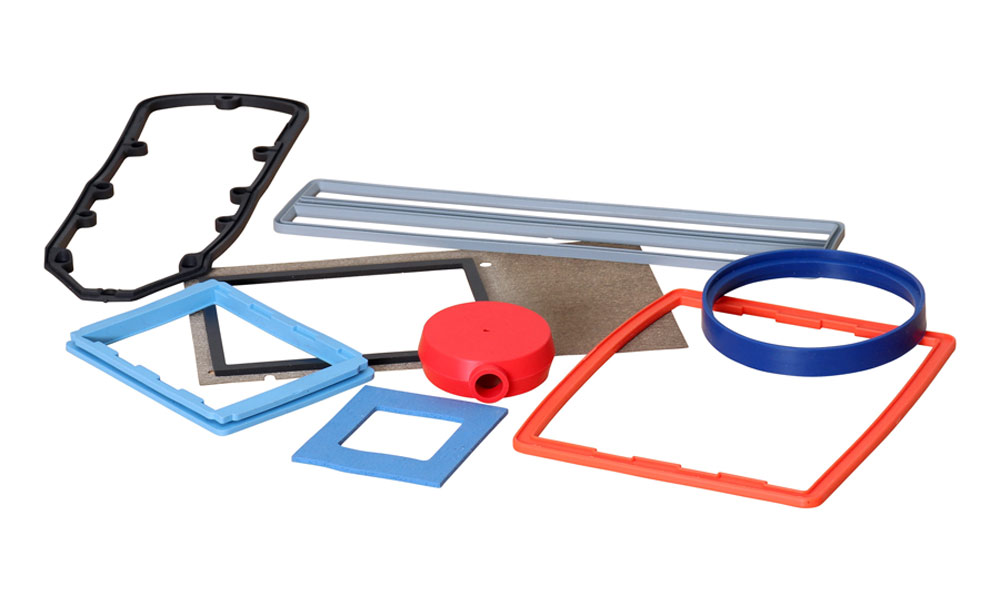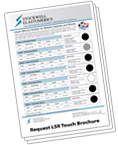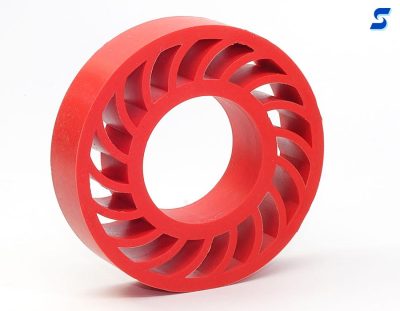Manufacturing
Liquid Silicone Injection Molding
Platinum cured LSR with custom color and additive capability
Platinum cured LSR with custom color and additive capability

The fast cure cycles associated with liquid injection molding (LIM) and improved performance properties of liquid silicone rubber make LSRs a good choice for small molded rubber components. Unlike most thermoplastic elastomers (TPRs and TPEs), liquid silicone rubber (LSR) remains flexible and elastic at -60°F and retains its properties up to 400°F. Since the major cost driver for molded components is labor, or time in the press, liquid silicone rubber is replacing gum base compression molded silicone in many applications.
The process of liquid injection molding (LIM) of liquid silicone rubber has a cost advantage over compression molding of gum based silicone, which is due to the cure cycle. Depending on the cross-section of the molded component, the cure cycle for LIM can take from 30 seconds up to 2 minutes – with an average cure time of 35 to 50 seconds. In contrast, compression molding of gum base silicones may take from 5 to 15 minutes per cure cycle. Therefore, a single or two cavity injection mold will still out-produce a compression mold with many cavities. With fewer cavities needed to support production, tooling costs and lead times are reduced. Fewer cavities results in less variation in critical dimensions as well. Stockwell Elastomerics’ tooling partner maintains an inventory of pre-cut steel plates to reduce lead time wherever possible – to facilitate fast design-to-production cycles.

Includes small samples of cured LSR materials to touch and feel.
Because injection molding has fast cycle times, Stockwell Elastomerics invested in a cryogenic de-flashing system to keep throughput up and keep part cost down. Using liquid nitrogen and small tumbling beads, the new system can remove parting line flash from difficult to reach areas on both simple and complex molded parts. The typical flash condition is reduced from .010″ to .015″ long, down to .005″ long maximum flash extension. Contact us for samples of silicone molded parts after cryogenic de-flashing – very close inspection is needed to see any the parting lines. The batch processing allows many parts to be de-flashed at once and has greatly reduced time and cost.
Molded gaskets with rectangular cross sections and gasket applications permitting .010″ to .015″ long parting line flash conditions may be provided with a “tear trim”. If the gasket design permits a tear trim, the flash grooves in the tooling may be designed in a manner that allows the molding process and finishing operation to avoid the cryogenic de-flashing process and reduce the cost of the gasket.


Liquid silicone molding compounds are purchased in Part A and Part B components from the major silicone producers such as Momentive (formerly GE Silicones) and Wacker Silicones. These compounds are usually mixed in a one to one ratio, with pigment added during the mixing process prior to injecting into the cavity and the cure. The elevated temperature and molding pressures of the liquid silicone injection molding (LIM molding) process enhance the cure. Liquid silicone rubber is supplied to Stockwell Elastomerics in airtight containers, pumped from the mix metering units into the tooling without exposure to the environment – therefore humidity is not a concern and generally the liquid silicone injection molding process is more consistent than rubber compression molding.
Liquid silicone molding compounds available from Stockwell Elastomerics range from 10 to 70 durometer Shore A. A touch brochure wtih samples of seven liquid silicone compounds is available for tactile reference. Available liquid silicone rubber compounds include:
Although the vast majority of molded gaskets are requested in the standard black or light gray, components are frequently molded in white or un-pigmented (clear). Further, there are 20 additional colors available in various shades of blue, green, red and yellow. Contact us to request a Color Inventory Chart (PDF) showing existing pigments that can be supplied without the cost of color formulation. There may be available silicone samples of some of these pigments as well.
Custom colors may be developed. However, the additional hardware to support a custom color may exceed $3500.00.
Another key benefit of liquid silicone molding is tight control over dimensional tolerances. As the injection molding process occurs with the tooling closed, cross-section tolerances are generally tighter than available from compression molding of gum base silicones. For most applications, Stockwell Elastomerics designs tooling and processes to meet the ARPM “A-2” precision tolerances (formerly RMA “A-2”) for both the closure (cross section) dimensions and the plan view (length and width) dimensions. A dimensional tolerances chart is available for reference.
 Liquid silicone rubber molding involves room temperature compound (Part “A” and Part “B” liquids) mixed and pumped into a hot mold. Tooling designs are simplified as liquid silicone rubber flows readily into very thin cross sections, tight radii and thick / thin features. Tooling surfaces do not have to be highly polished, and draft angles are not required to facilitate removal of the finished component from the mold. When the cure cycle is complete, the molded silicone gasket (LIM gasket) can be removed without concern of distortion or tearing since the silicone is fully cured. (TPRs and TPEs would require ejector pins and draft angles designed into the molds.)
Liquid silicone rubber molding involves room temperature compound (Part “A” and Part “B” liquids) mixed and pumped into a hot mold. Tooling designs are simplified as liquid silicone rubber flows readily into very thin cross sections, tight radii and thick / thin features. Tooling surfaces do not have to be highly polished, and draft angles are not required to facilitate removal of the finished component from the mold. When the cure cycle is complete, the molded silicone gasket (LIM gasket) can be removed without concern of distortion or tearing since the silicone is fully cured. (TPRs and TPEs would require ejector pins and draft angles designed into the molds.)
Contact us to see samples of liquid silicone injection molding items containing undercuts, straight walls and similar design features that were produced from molds designed to utilize the unique properties of LSR.
Stockwell Elastomerics’ latest developments in liquid silicone injection molding include increasing shot size (over 300 grams) to produce LSR molded gaskets as large as 8″ wide x 18″ long for analytical instrumentation, medical diagnostic equipment and telecommunication housings. This same capability allows liquid silicone molding of cured sheets, .020″ thick through .188″ thick in 12″ x 12″ sheet mold; secondary cutting and adhesive lamination is available.
Although silicon rubber is called out sometimes called out in specifications, silicone rubber is the widely accepted terminology used among in the synthetic rubber industry.
Similarly, the terms liquid silicone rubber molding, liquid silicone rubber injection molding, liquid silicone molding, silicone liquid molding, liquid silicone injection molding, silicone injection molding, LIM molding, silicone rubber molding and silicone molding are all used frequently and mostly interchangeably.
Contact Us for further assistance with custom liquid silicone rubber molding / liquid injection molding (LIM).